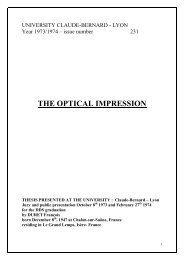english version(pg40to78) - Pr. François Duret
english version(pg40to78) - Pr. François Duret
english version(pg40to78) - Pr. François Duret
Create successful ePaper yourself
Turn your PDF publications into a flip-book with our unique Google optimized e-Paper software.
F <strong>Duret</strong> and Coll. <strong>Pr</strong>incipes de fonctionnement et applications techniques de l’empreinte optique dans l’exercice de cabinet<br />
(traduction Anglaise)<br />
Page 79<br />
of have a set of knowledge of shapes associated to the capture), the<br />
calculator can’t spontaneously position the points and the coordinates<br />
together without precise indication of their respective identities or<br />
without the precise positioning of the capture system with regards to<br />
the object. This method has been worked on in the USA (1968), in<br />
England (1978) 8 and in Germany (1979) 9 (Fig. 8).<br />
[Fig. 8: the optical probe of HEITLINGER and RÖDDER (1979) (we<br />
notice the triangulation of the fibers)]<br />
The third method, called moiré, described for the first time by Lord<br />
RAYLEIGH in 1874 10 is in our eyes the only interesting method today<br />
for the dental surgeon. What characterises the moiré effect is the<br />
obtaining a macroscopic structure by superposing two neutral<br />
microscopic structures (Fig. 9 and 10). It is about an interferometric<br />
phenomenon which, instead of superposing two waves, superposes<br />
two networks of which we know the profile. The superposition of<br />
these two networks, with a known dimension, leads to obtaining level<br />
curves with mathematically determined spacing. These level curves<br />
which appear on the object have the great advantage of putting the<br />
third dimension of the image of the studied object in two dimensions<br />
(the tooth). This method has been the subject of a certain number of<br />
works in the USA to know the movement or deformations of the<br />
dental and prosthetic structures 11 . It is only in 1978 that the first works<br />
started in France for dental coordinates capture method 12 to 15 .<br />
Les Cahiers de <strong>Pr</strong>othèse (50) pp 73 – 110, 1985



